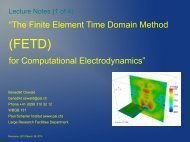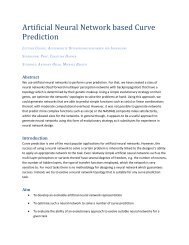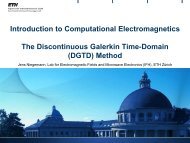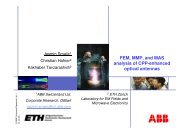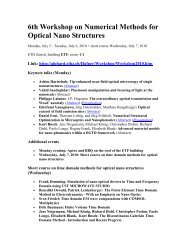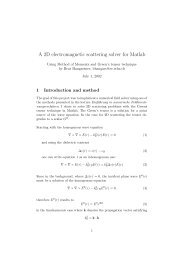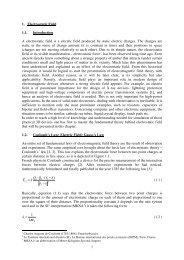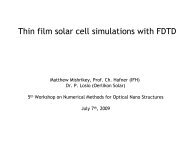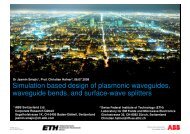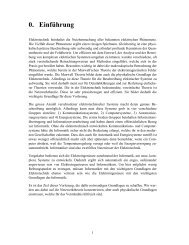Nano-Photonics and Plasmonics in COMSOL Multiphysics
Nano-Photonics and Plasmonics in COMSOL Multiphysics
Nano-Photonics and Plasmonics in COMSOL Multiphysics
Create successful ePaper yourself
Turn your PDF publications into a flip-book with our unique Google optimized e-Paper software.
<strong>Nano</strong>-<strong>Photonics</strong> <strong>and</strong> <strong>Plasmonics</strong> <strong>in</strong><br />
<strong>COMSOL</strong> <strong>Multiphysics</strong><br />
Speaker: Dr. Thierry Luthy (<strong>COMSOL</strong> GmbH, Zurich)<br />
Credits: Dr. Yaroslav Urzhumov (<strong>COMSOL</strong> Inc, Los Angeles)<br />
ETH Zürich<br />
08.07.2009
Outl<strong>in</strong>e<br />
<strong>COMSOL</strong> product overview: company, product <strong>and</strong> RF module<br />
DEMO: An illustrated surface plasmon example<br />
Deal<strong>in</strong>g with periodicity, dispersion <strong>and</strong> <strong>in</strong>f<strong>in</strong>ity<br />
Customiz<strong>in</strong>g equations<br />
Equation-based model<strong>in</strong>g<br />
complexity
Introduction <strong>COMSOL</strong><br />
Basic concepts<br />
Product structure<br />
The RF module
The <strong>Multiphysics</strong> perspective<br />
Mechanics<br />
Fluid Dynamics<br />
Electrodynamics Heat<br />
<strong>Multiphysics</strong><br />
Chemical Reactions Acoustics<br />
User def<strong>in</strong>ed PDE<br />
Beneficial for both s<strong>in</strong>gle- <strong>and</strong> multi-field analysis:<br />
Reality, Flexibility, Synergy, Openness
<strong>COMSOL</strong> - the <strong>Multiphysics</strong> people<br />
Sp<strong>in</strong>-off of KTH Stockholm (1986)<br />
Science & Eng<strong>in</strong>eer<strong>in</strong>g Software<br />
today 16 branch offices<br />
worldwide net of distributors<br />
12’500 licenses <strong>and</strong> 50’000 users<br />
annual growth <strong>in</strong> CH ~36%
<strong>COMSOL</strong> <strong>Multiphysics</strong> Product Structure
<strong>Plasmonics</strong> model challenges <strong>and</strong> their <strong>COMSOL</strong><br />
solutions<br />
Large field discont<strong>in</strong>uities, currents <strong>and</strong> charges on<br />
curved boundaries<br />
Automatically <strong>and</strong> accurately h<strong>and</strong>led by Vector Element FEM;<br />
both FD <strong>and</strong> TD<br />
Accurate spectra, effective medium parameters Parametric sweeps, or solve once for one wavelength<br />
Temporal dispersion model FEFD method needs only ε c (ω)<br />
Light scatter<strong>in</strong>g Scattered field formulation<br />
Inf<strong>in</strong>itely extended doma<strong>in</strong>s <strong>and</strong> objects Scatter<strong>in</strong>g/Matched b.c., PMLs, Impedance b.c.<br />
Radiation <strong>and</strong> scatter<strong>in</strong>g cross-sections Far Field <strong>in</strong>tegral; S-parameters<br />
Launch<strong>in</strong>g specific wave forms Port b.c., Boundary Mode Analysis<br />
Resolv<strong>in</strong>g plasmonic sk<strong>in</strong> depth Boundary layer mesh; Impedance b.c.<br />
Nonl<strong>in</strong>ear effects FETD formulations<br />
You name it!.. We have probably seen it…
Overview of Analysis Types<br />
<strong>Photonics</strong><br />
Frequency-Doma<strong>in</strong> Time-Doma<strong>in</strong><br />
Driven Eigenfrequency Eigenmode<br />
Total-field<br />
Scattered-field<br />
Paraxial<br />
Quadratic Eigenvalue<br />
Nonl<strong>in</strong>ear Eigenvalue<br />
Perpendicular<br />
Periodic<br />
Three levels of difficulty:<br />
i. Fully predef<strong>in</strong>ed <strong>in</strong> <strong>COMSOL</strong><br />
ii. M<strong>in</strong>imum changes to the predef<strong>in</strong>ed equations<br />
iii. Equation-based model<strong>in</strong>g: maximum flexibility<br />
L<strong>in</strong>ear Nonl<strong>in</strong>ear<br />
Non-dispersive<br />
Trivial dispersion<br />
Drude-Lorentz
Levels of work<strong>in</strong>g with <strong>COMSOL</strong><br />
• Ready-to-use <strong>in</strong>terface for st<strong>and</strong>ard problems<br />
– Fully-predef<strong>in</strong>ed equations <strong>and</strong> BND conditions<br />
– Powerful draw<strong>in</strong>g <strong>and</strong> mesh<strong>in</strong>g <strong>in</strong>terface<br />
– Solver defaults<br />
– Help, Report Generator etc.<br />
• Customiz<strong>in</strong>g <strong>COMSOL</strong>-def<strong>in</strong>ed equations<br />
– Slight modifications of exist<strong>in</strong>g equations<br />
– e.g. magneto-electric (chiral) media<br />
– e.g. Bloch-Floquet eigenmode analysis of dispersive<br />
periodic structures<br />
• Fully equation-based model<strong>in</strong>g<br />
– Full flexibility<br />
– Time doma<strong>in</strong> models of dispersive media
DEMO – Surface Plasmons<br />
Draw <strong>and</strong> Mesh<br />
Perfectly matched layers (PMLs)<br />
Modification of expressions (<strong>in</strong>cident angle)<br />
Parametric solver<br />
Resolution of sk<strong>in</strong>-depth vs. Impedance BND conditions
Surface Plasmons Demo<br />
4 μm<br />
H field perpendicular to the „wall“<br />
Wavelength 600 nm<br />
Metal<br />
Air
Surface Plasmons Demo<br />
4 μm<br />
Perfectly Matched Layer (PML)<br />
Metal<br />
Air
Surface Plasmons Demo<br />
4 μm<br />
Perfectly Matched Layer (PML)<br />
Metal<br />
Air
Surface Plasmons Demo<br />
Impedance Boundary Condition<br />
Perfectly Matched Layer (PML)<br />
Air
The 5 Steps of Model<strong>in</strong>g
Deal<strong>in</strong>g with periodicity, dispersion <strong>and</strong><br />
<strong>in</strong>f<strong>in</strong>ity<br />
Periodic boundary conditions<br />
Periodic meshes<br />
Dispersive media <strong>in</strong> the frequency doma<strong>in</strong><br />
Scattered field analysis<br />
Unlimited Mesh functionality
Periodic boundary conditions<br />
Goal of simulation: f<strong>in</strong>d eigenmodes of a honeycomb lattice<br />
photonic crystal, <strong>and</strong> view them <strong>in</strong> a large doma<strong>in</strong><br />
This lattice is a common motif <strong>in</strong> carbon-based crystals<br />
(graphite, graphene) <strong>and</strong> organic polymers (C6 r<strong>in</strong>gs).<br />
Honeycomb lattices have been used <strong>in</strong> design of photovoltaic<br />
cells, photonic crystal fibers <strong>and</strong> negative-<strong>in</strong>dex super-lenses
Periodic boundary conditions<br />
Irreducible unit cell: solution space Larger doma<strong>in</strong>, multiple periods<br />
?<br />
Example: honeycomb lattice crystal
Visualiz<strong>in</strong>g the Bloch wave<br />
Periodicity tools even more powerful <strong>in</strong> 3D
Reflection/transmission<br />
spectra of a periodic<br />
structure<br />
Goal: calculate normalized<br />
reflectance, transmittance <strong>and</strong><br />
absorbance of a perforated nano-film<br />
(photonic crystal slab)<br />
Set-up tricks:<br />
double-periodic boundary conditions,<br />
user-def<strong>in</strong>ed port boundaries,<br />
S-parameters.<br />
<strong>in</strong>cident<br />
reflected<br />
transmitted<br />
Applications:<br />
Optical characterization<br />
of nanostructures<br />
Extract<strong>in</strong>g effective<br />
medium parameters of<br />
metamaterials<br />
20
Air<br />
Above: a generic geometry (hole array)<br />
Draw any unit cell for your own metamaterial design!<br />
Dielectric film<br />
Air-filled hole<br />
21
Periodic mesh generation: Node identity!<br />
1. Select boundaries 2 <strong>and</strong> 5 (the first equivalent pair).<br />
2. Click Copy Mesh button (red double triangle).<br />
3. Go to the Mesh Mode to see that the boundary mesh<br />
has been translated.
Dielectric film may have dispersive<br />
permittivity<br />
Just enter the relation!<br />
2<br />
ν p<br />
ε ( ν ) =<br />
εb<br />
−<br />
ν ( ν − iγ<br />
)<br />
Three <strong>COMSOL</strong> ways of enter<strong>in</strong>g<br />
material data:<br />
Analytic expression (Global,<br />
Scalar, Subdoma<strong>in</strong>, etc.)<br />
Interpolation function – provide<br />
ASCII file with a lookup table<br />
Reference to external m-function<br />
(MATLAB <strong>in</strong>terface)
S-parameters <strong>and</strong> metamaterial characterization<br />
transmitted<br />
reflected<br />
absorbed<br />
Port boundary: easy way to launch a<br />
specific wave form<br />
Provides complex-valued S-parameter<br />
matrix<br />
S11=r=reflectance (1 1)<br />
S21=t=transmittance (1 2)<br />
Effective medium approximation: use<br />
Fresnel-Airy formulas for a f<strong>in</strong>itethickness<br />
slab<br />
Metamaterial analysis: <strong>in</strong>vert those<br />
formulas to extract effective medium<br />
parameters from S-parameters<br />
{S11,S21} -> {Z eff , n eff } -> {ε eff , μ eff }<br />
Reference: Smith D. R., Schultz S.,<br />
Markos P. <strong>and</strong> Soukoulis C. M. 2002,<br />
Phys. Rev. B 65 195104
Scattered-Field Formulation<br />
Basic idea:<br />
Instead of solv<strong>in</strong>g<br />
solve<br />
L [u] = 0,<br />
L [u <strong>in</strong> + u sc] = 0<br />
<br />
L [u sc] = - L [u <strong>in</strong>]<br />
Illustration: cloak of <strong>in</strong>visibility on<br />
human head
Customized Scattered-Field formulations<br />
Problem: A s<strong>in</strong>gle particle (or group of<br />
particles) on <strong>in</strong>f<strong>in</strong>itely extended<br />
substrate<br />
Set-up issue: PML can only be<br />
perfectly matched to one medium<br />
(either air/solvent or the substrate)<br />
Air Glass<br />
Avoid<strong>in</strong>g artificial reflections on the<br />
boundary between two PMLs may be<br />
difficult<br />
Particle<br />
Solution: modify “<strong>in</strong>cident” field<br />
<br />
expressions<br />
If the “<strong>in</strong>cident” field is an exact<br />
solution without the particle, then the<br />
Air-matched PML Glass-matched PML<br />
“scattered” field is small at some<br />
distance away from the particle.<br />
Plot of the “scattered” field<br />
For <strong>in</strong>f<strong>in</strong>ite metallic doma<strong>in</strong>s don’t use<br />
PMLs but scatter<strong>in</strong>g BND condition.
Far Field – Antenna - Scatter<strong>in</strong>g<br />
near field radiation pattern<br />
phi component of the electric field far field<br />
Far Field feature:<br />
Used for calculat<strong>in</strong>g radiation pattern <strong>and</strong> differential<br />
scatter<strong>in</strong>g cross-section
Unlimited 3D Mesh<strong>in</strong>g Functionality
Free comb<strong>in</strong>ation of mesh types
Customiz<strong>in</strong>g <strong>COMSOL</strong> equations<br />
Modify<strong>in</strong>g constitutive relations:<br />
Magneto-electric (chiral) media<br />
Modify<strong>in</strong>g built-<strong>in</strong> equations:<br />
Time-doma<strong>in</strong> model<strong>in</strong>g of lossless plasma with<br />
dispersive permittivity
Model<strong>in</strong>g chiral (magneto-electric) media<br />
The most general dispersion relation for a l<strong>in</strong>ear medium <strong>in</strong>cludes 4<br />
electromagnetic response tensors: r r t r<br />
t<br />
D=<br />
εE+<br />
ζ<br />
r t r t<br />
B = μH<br />
+ ζ<br />
For an isotropic medium consist<strong>in</strong>g on non-centrosymmetric unit cells<br />
(crystals or metamaterials):<br />
Chirality parameter χ controls polarization rotation<br />
DH<br />
BE<br />
r r r<br />
D=<br />
εE<br />
−iχH<br />
r r r<br />
B = μH<br />
+ iχE<br />
H<br />
r<br />
E
Geometry<br />
Geometry consists of 5 adjacent<br />
rectangular blocks, each 1x1<br />
“meter” <strong>in</strong> cross-section (could be<br />
1 micron as well – only the ratio<br />
wavelength/size matters)<br />
Physical doma<strong>in</strong>: 3m long<br />
PML 1 <strong>and</strong> 2: thickness 0.2m,<br />
centered at x1=-1.6 <strong>and</strong> x2=1.6<br />
Chiral slab: thickness L=1m,<br />
centered at the orig<strong>in</strong> (x=y=z=0)<br />
PML<br />
Air<br />
Chiral<br />
Chiral medium
Modify<strong>in</strong>g built-<strong>in</strong> constitutive relations<br />
<strong>in</strong> chiral medium<br />
r r χ r<br />
D =<br />
εE<br />
−i<br />
H<br />
c<br />
r r χ r<br />
B = μH<br />
+ i E<br />
c
Results: polarization rotation<br />
Click Solve<br />
Open Postprocess<strong>in</strong>g Plot<br />
Parameters, enable Slice <strong>and</strong><br />
Arrow plots<br />
Slice tab: type expression<br />
atan(abs(Ey)/abs(Ez))/pi<br />
This is polarization rotation angle <strong>in</strong><br />
fractions of pi radian<br />
Arrow tab: choose “Electric field”<br />
from “Predef<strong>in</strong>ed quantities”<br />
Electric field polarization is clearly<br />
rotated by 45 degrees (or 0.25*pi<br />
radian)
Negative refraction of circular polarized<br />
wave<br />
For circularly polarized waves,<br />
effective <strong>in</strong>dices are n±=1±χ<br />
Sufficiently large chirality<br />
parameter rotates properly<br />
h<strong>and</strong>ed waves so much as to fully<br />
compensate (<strong>and</strong> w<strong>in</strong> over)<br />
natural rotation of the circular<br />
polarization<br />
Backward waves => Negative<br />
refraction!<br />
Reference: J.B. Pendry, “A chiral<br />
route to negative refraction”,<br />
Science 306, 1353 (2004).<br />
k<br />
clockwise<br />
clockwise<br />
counterclockwise<br />
To excite this wave,<br />
use surface current<br />
Js=[0 –i 1]
Time-doma<strong>in</strong> model<strong>in</strong>g of lossless plasma<br />
with dispersive permittivity<br />
F<strong>in</strong>ite Element Time Doma<strong>in</strong> (FETD) analysis <strong>in</strong> <strong>COMSOL</strong> is<br />
implemented <strong>in</strong> terms of vector potential A us<strong>in</strong>g the V=0 gauge:<br />
It satisfies equation<br />
r r r r<br />
E = −∂r<br />
t A,<br />
B = r ∇×<br />
r<br />
A r<br />
−1<br />
∂ ε ∂ + σ∂<br />
A−∂<br />
P+<br />
∇×<br />
μ ∇×<br />
A=<br />
0<br />
t<br />
tA<br />
t t<br />
The most general isotropic dielectric function that can be modeled<br />
without additional degrees of freedom:<br />
2<br />
b c<br />
iσ<br />
ω p<br />
ε ( ω ) = a + + = ε 0 ( ε<br />
2<br />
∞ − − 2<br />
ω ω<br />
ω ω<br />
The f<strong>in</strong>al equation after factoriz<strong>in</strong>g ε 0 ,μ 0 this becomes <strong>in</strong> SI units:<br />
μ ∂ ε ε ∂<br />
0<br />
t<br />
0<br />
∞<br />
r<br />
r<br />
2<br />
tA<br />
+ μ0σ∂<br />
tA<br />
+ kp<br />
r<br />
r<br />
−1<br />
A+<br />
∇×<br />
μ ∇×<br />
A = 0<br />
)<br />
Plasmonic term
Implementation<br />
The major part of the equation is predef<strong>in</strong>ed <strong>in</strong> <strong>COMSOL</strong> st<strong>and</strong>ard GUI.<br />
You only need to enter the plasmonic term<br />
μ ∂ ε ε ∂<br />
0<br />
t<br />
0<br />
∞<br />
r<br />
r<br />
2<br />
tA<br />
+ μ0σ∂<br />
tA<br />
+ kp<br />
r<br />
r<br />
−1<br />
A+<br />
∇×<br />
μ ∇×<br />
A = 0<br />
Plasmonic term
Results: plasma echo <strong>in</strong> l<strong>in</strong>ear electron density<br />
gradient
<strong>COMSOL</strong> Equation-based model<strong>in</strong>g<br />
Non-l<strong>in</strong>ear Eigenvalue problems<br />
classical Eigenvalue Problem (EP)<br />
Quadratic Eigenvalue Problem (QEP)<br />
Generalized Eigenvalue Differential Equation (GEDE)<br />
Bloch-Floquet-Eigenmode<br />
Surface charge <strong>in</strong>tegral equations (SCIE)
Examples of non-l<strong>in</strong>ear eigenvalue<br />
problems<br />
The resonance <strong>in</strong> PEC waveguides is a<br />
classical eigenvalue problem (EP). If the<br />
walls are not PEC but lossy (us<strong>in</strong>g<br />
Impedance BC.) the waveguide becomes<br />
dispersive, the EP nonl<strong>in</strong>ear<br />
Dispersive photonic b<strong>and</strong> structures<br />
Eigenvalue problem becomes quadratic (QEP)<br />
regardless of the complexity of temporal<br />
dispersion, ε(ω)<br />
Surface Plasmon Resonances (e.g. of <strong>Nano</strong>holes)<br />
as Electrostatic Eigenvalues <br />
Generalized Eigenvalue Differential Equation<br />
(GEDE)<br />
− ∇<br />
2<br />
E<br />
z<br />
2<br />
= ε ( ω)<br />
ω E<br />
∇( θ ∇ϕ<br />
) = λ ∇<br />
r r<br />
n<br />
n<br />
2<br />
ϕ<br />
n<br />
z
<strong>COMSOL</strong> approach of treat<strong>in</strong>g nonl<strong>in</strong>ear EP<br />
Traditionally, nonl<strong>in</strong>ear eigenvalue problems are hard to solve.<br />
– Iterative approach to nonl<strong>in</strong>ear eigenvalue problems requires a good<br />
<strong>in</strong>itial guess; convergence is not guaranteed.<br />
– One can only obta<strong>in</strong> a s<strong>in</strong>gle eigenmode at a time, from a given <strong>in</strong>itial<br />
guess.<br />
QEP [1] <strong>and</strong> GEDEs [3,4] are easily implemented <strong>in</strong><br />
<strong>COMSOL</strong>'s weak mode.<br />
[1] Credit: Dr. Marcelo Davanco, Univ. of Michigan, 2007, Published <strong>in</strong>:<br />
Davanco, Urzhumov, Shvets, Opt. Express 15, p.9681 (2007).<br />
[2] Bergman D., PRB 19, 2359 (1979); Bergman D., Stroud D., Solid State<br />
Phys. 46, 147 (1992);<br />
Stockman M., Faleev S., Bergman D., PRL 87, 167401 (2001).<br />
[3] Shvets, Urzhumov, PRL 93, p. 243902 (2004).
<strong>COMSOL</strong> access to the weak form<br />
PDE equations are easily converted<br />
to the “weak form”<br />
– multiply with the test function<br />
(u_test)<br />
– <strong>in</strong>tegration by parts (Gauss-<br />
Stokes theorems)<br />
r<br />
2Example:<br />
Laplace 2operator<br />
u = 0 → ( ∇ u)<br />
utestdV<br />
= ( −)<br />
( ∇u)<br />
⋅(<br />
∇utest<br />
∇ ∫ ∫<br />
Weak term:<br />
Example GEDE<br />
n<br />
r<br />
∇( θ ∇ϕ<br />
) = λ ∇<br />
r r<br />
n<br />
r<br />
r<br />
) dV<br />
ux*ux_test + uy*uy_test + uz*uz_test<br />
2<br />
ϕ<br />
n<br />
=<br />
0
<strong>COMSOL</strong> Implementation<br />
weak = ux*test(ux)+uy*test(uy)+uz*test(uz)<br />
dweak= -(uxt*test(ux)+uyt*test(uy)+uzt*test(uz))<br />
Note: -ut is the same as lambda*u<br />
Enter weak terms just as you write them on paper!<br />
r<br />
2<br />
∇ u = λ ∇<br />
n<br />
n<br />
2<br />
u<br />
n
Example Surface Plasmon Resonance (GEDE)<br />
Sample surface plasmon resonances of a plasmonic tetramer<br />
1st <strong>and</strong> 20th eigenvalue
Emerg<strong>in</strong>g field: plasmonic metafluids<br />
Manoharan et al.: colloidal solutions<br />
with clusters of various symmetric<br />
forms [Science, 2003]<br />
Some clusters are useful as build<strong>in</strong>g<br />
blocks for photonic crystals<br />
Others may be useful even <strong>in</strong> solution<br />
Resonances of plasmonic clusters<br />
modify electromagnetic properties of<br />
liquids<br />
Manipulate electric permittivity,<br />
magnetic permeability, chirality of<br />
liquids<br />
Electric dipole<br />
resonance<br />
Magnetic dipole<br />
resonance<br />
fcc<br />
block
Plasmonic crystal superlens (doable with QEP)<br />
<strong>Nano</strong>structured<br />
super-lens*<br />
Magnetic field beh<strong>in</strong>d plane<br />
wave illum<strong>in</strong>ated double-slit:<br />
D = λ/5, separation 2D<br />
Hot spots at the<br />
super-lens<br />
Shvets, Urzhumov, PRL 93, 243902 (2004);<br />
Davanco, Urzhumov, Shvets, Opt. Express 15, p.9681 (2007).<br />
Electric field profiles<br />
Blue w/w p = 0.6, X = -0.2l<br />
Red w/w p = 0.6, X = 0.8 λ no damp<strong>in</strong>g<br />
Black same as red, but with damp<strong>in</strong>g<br />
Dotted w/w p = 0.606 (outside of the<br />
left-h<strong>and</strong>ed b<strong>and</strong>)
Surface charge <strong>in</strong>tegral equations (SCIE)<br />
Surface <strong>in</strong>tegral eigenvalue equation for surface charge [3]:<br />
∫ K ( s,<br />
s')<br />
u(<br />
s')<br />
dS'<br />
= λu(<br />
s)<br />
Input as -u_time<br />
Fredholm <strong>in</strong>tegral = Boundary Integration Variable<br />
Usage of this variable (sigma<strong>in</strong>t) <strong>in</strong> the weak mode<br />
Quadrupole plasmon<br />
resonance of a<br />
nanor<strong>in</strong>g<br />
[3] Mayergoyz I.D., Fredk<strong>in</strong> D.R., Zhang Z., Phys. Rev. B 72, 155412 (2005)
Outl<strong>in</strong>e<br />
<strong>COMSOL</strong> product overview: company, product <strong>and</strong> RF module<br />
DEMO: An illustrated surface plasmon example<br />
Deal<strong>in</strong>g with periodicity, dispersion <strong>and</strong> <strong>in</strong>f<strong>in</strong>ity<br />
Customiz<strong>in</strong>g equations<br />
Equation-based model<strong>in</strong>g<br />
complexity
Conclud<strong>in</strong>g remarks<br />
<strong>COMSOL</strong> covers the majority of st<strong>and</strong>ard simulation tasks <strong>in</strong> <strong>Plasmonics</strong><br />
<strong>and</strong> <strong>Nano</strong>-<strong>Photonics</strong><br />
Frequency-doma<strong>in</strong>, time-doma<strong>in</strong>, modal analyses<br />
Unprecedented flexibility comb<strong>in</strong>ed with hi-end numerical analysis tools<br />
Users can <strong>in</strong>vent new types of analysis; creativity is welcomed<br />
Every new version br<strong>in</strong>gs more powerful features! E.g. In Release 3.5:<br />
New time-dependent solvers (generalized-alpha, segregated)<br />
Optimization <strong>and</strong> sensitivity analysis<br />
Parametric sweeps wrapped around eigenmode or time-dependent<br />
analysis
How to get started?<br />
Tell us about your plans,<br />
requirements, models.<br />
Order your free trial version: www.comsol.com/<br />
support@comsol.com<br />
Get: - support from an <strong>in</strong>ternational team<br />
- free <strong>in</strong>troductory kits to various applications<br />
- free conference proceed<strong>in</strong>gs<br />
- free m<strong>in</strong>icourses<br />
- Intensive tra<strong>in</strong><strong>in</strong>g courses<br />
AC/DC, Chem. Eng<strong>in</strong>eer<strong>in</strong>g, Mechanics, RF
Jo<strong>in</strong> the Leaders <strong>in</strong> <strong>Multiphysics</strong> Simulation<br />
• H<strong>and</strong>s-on M<strong>in</strong>icourses<br />
• Keynote Talks <strong>and</strong> User Presentations<br />
• Exhibition <strong>and</strong> Poster Session<br />
• Demo Stations<br />
• Tutorial Presentations<br />
• Awards Banquet<br />
www.comsol.eu/conference2009



